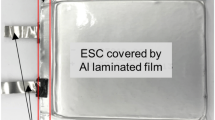Abstract
Lithium polymer batteries are an improvement from the existing lithium ion batteries in terms of the risks of electrolyte leakage and explosion. Demand for lithium polymer batteries is rapidly increasing because of their advantages such as stability, light, and higher degree of freedom of shape. Accordingly, the demand for aluminum pouches, which are the exterior material of lithium polymer batteries, is increasing and research and development of aluminum pouches are actively being conducted. In the case of aluminum pouches, the forming area and depth that can accommodate the battery cell are increased according to the capacity of the battery, and stable formability is essential for aluminum pouches. In this study, manufacturing processes were changed to examine ways to improve formability. First, by changing the process order so that the surface treatment coatings on both sides of the aluminum foil were carried out simultaneously, the number of times when there was contact of the nylon film with the work roll was reduced. As a result, formability was improved because damage to the surface of the nylon film was reduced and the slipperiness was maintained. In addition, with regard to the drying temperature of the adhesive that constitutes the innermost layer, as the drying temperature increased (120 °C), solvent volatility increased, leading to stronger adhesion between the interfaces and resulting in improved formability.
Similar content being viewed by others
References
Y. Kim, Trend of the standardization of secondary batteries, Korean Agency for Technology and Standards (KATS) Technical Report, Publication No. 11-1411095-000009-06, 84 Mar. 31 (2016) 6–7.
J. Choi and I. Ha, Next-generation Secondary Batteries under Accelerating Competition for Development being Accelerated, LG Economic Research Institute (2017) 1–6.
Y. Kim and D. Yook, Influences of chromate coating conditions on the surface appearance and corrosion resistance of aluminum alloy for Can-stock, Journal of the Corrosion Science Society of Korea, 25 (2) (1996) 180–191.
Korea Petrochemical Ind. Co., Ltd., Understanding of Plastic Properties, 27 (in Korean).
Y. Han, G. Shin, H. Kim, S. Kwon and S. Park, An experimental study on the characteristics of friction between moving web and roller, J. of Korea Society of Precision Engineering (1997) 1159–1162.
M. Kang, Press Sheet Metal Processing, Cheongmungag (1998) 167–172.
Hwasung Co., Ltd., Adhesive Common Sense, http://www.hsadhesive.co.kr (Accessed 2018.09).
M.-W. Cho, J.-Y. Kim, D.-S. Kim and K.-K. Choi, The effect of solvent evaporation of dentin adhesive on bonding efficacy, Journal of Korean Academy of Conservation Dentistry, 35 (5) (2010) 321–333.
J. Yoo and J. Chun, Application of polyurethane adhesive, Polymer Science and Technology, 10 (5) (1999) 578–588.
M. Yu, A study on factors influencing the formability of the aluminum pouch for secondary battery, Master’s degree Dissertation, Hanbat Nat’l University (2017) 42–45.
Acknowledgments
This work was supported by the National Research Foundation of Korea (NRF) grant funded by the Korea government (MISP) (No. 2018R1A6A1A03026005) and supported by Basic Science Research Program through the National Research Foundation of Korea (NRF) funded by the Ministry of Education (No. 2018M3A7B4071066). This research was supported by Hanbat National University Accounting Research Fee for the 2018 academic year.
Author information
Authors and Affiliations
Corresponding author
Additional information
Recommended by Associate Editor Seong-Chan Jun
Dong Soo Kim received his M.S. and Ph.D. degrees in Mechanical Engineering from Yung Nam University, Korea, in 1991 and 2001, respectively. He worked for the Nano Mechanical System Research Division at Korea Institute of Machinery & Materials as the general manager from 1991 to 2011, and joined the Department of Creative Convergence Engineering at Hanbat National University, Daejeon, Korea, as a Professor in 2012. His research interests include printed electronics, R2R printing, and RP system.
Min Sook Yu received the M.S. degree in the Creative Convergence Engineering from the Hanbat National University, Daejeon, Korea, in 2017. She is currently working as a researcher for the TOPnC Co., Ltd. Her research interests include the pouch film for lithium battery.
Rights and permissions
About this article
Cite this article
Yu, M., Song, M., Kim, M. et al. Experimental study on the formability of aluminum pouch for lithium polymer battery by manufacturing processes. J Mech Sci Technol 33, 4353–4359 (2019). https://doi.org/10.1007/s12206-019-0831-y
Received:
Revised:
Accepted:
Published:
Issue Date:
DOI: https://doi.org/10.1007/s12206-019-0831-y



